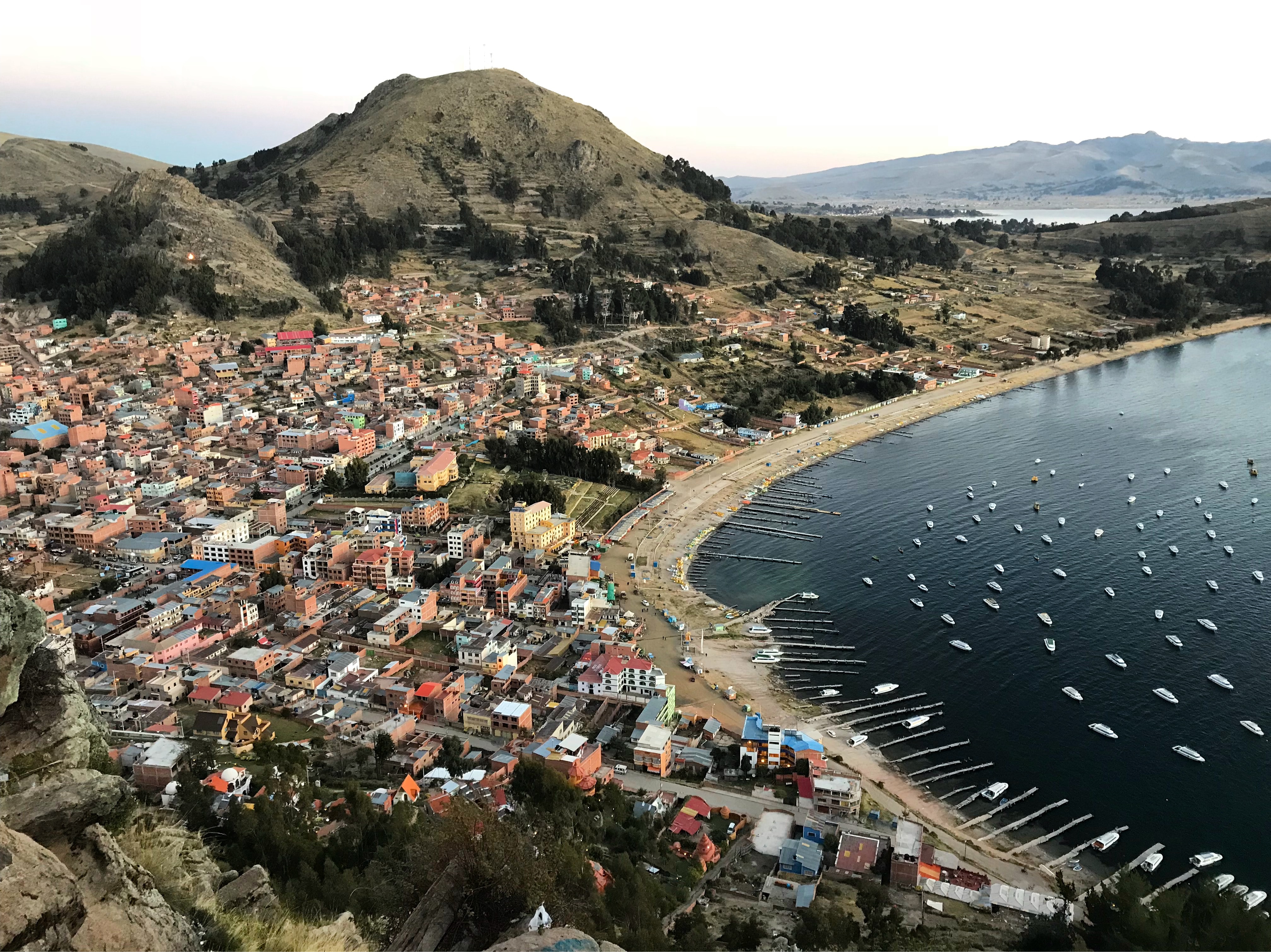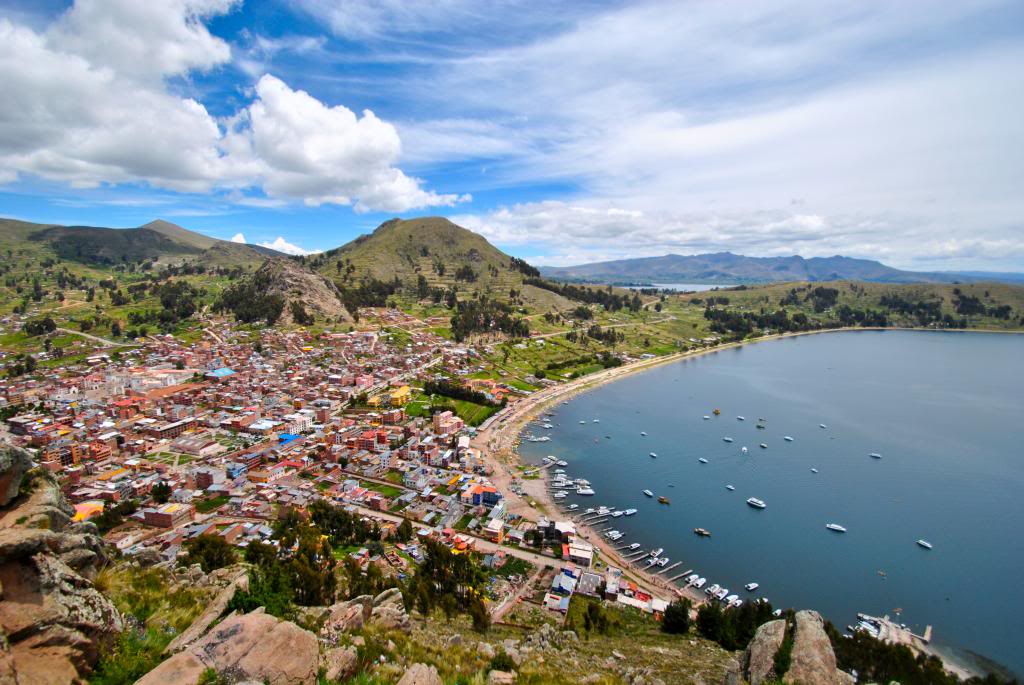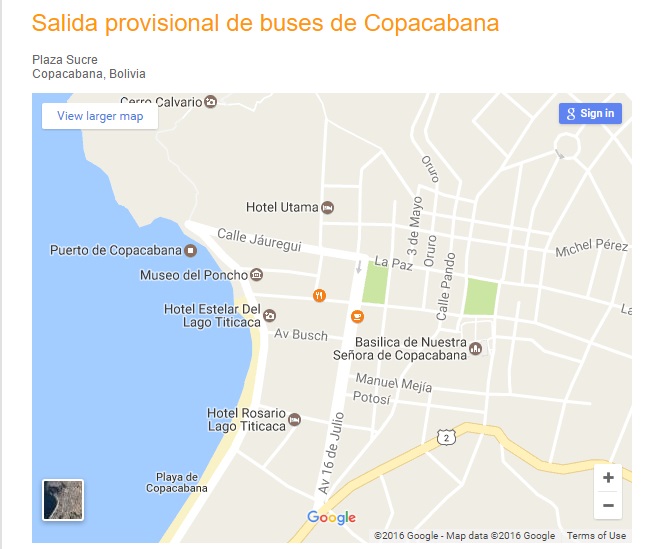Puno to Copacabana by bus takes about 4 hours. From Bolivia, La Paz to Copacabana also takes about 4 hours by bus. This guide will give you all the information you need in order to plan your trip from La Paz and Puno to Copacabana and Isla del Sol in Bolivia. You will find here bus and boat schedules and suggestions on what to do and where to go.
Bus from La Paz to Copacabana
La Paz to Copacabana by bus takes about 4 hours. Buses leave throughout the day but the last bus to leave from the main terminal leaves at 13:30. There are no night buses to Copacabana because buses need to cross by ferry the strait of Tiquina which closes at night.
Schedule and prices for La Paz to Copacabana bus:
| Bus Company | Bus Class | Time of Departure | Time of Arrival | Price | Additional Information |
| Vicuna Travel | Normal | 07:30 | 11:30 | US$ 4.38 | Doesn’t include the crossing of Tiquina (2 Bs) |
| Turisbus | Tourist | 07:30 | 11:30 | US$ 19 | Includes the crossing of Tiquina. Programmed stops to take pictures and pick-up service. |
| Trans Titicaca | Normal | 08:00 | 12:00 | US$ 3.94 | Doesn’t include the crossing of Tiquina (2 Bs) |
| Diana Tour | Normal | 08:00 | 12:00 | US$ 4.38 | Doesn’t include the crossing of Tiquina (2 Bs) |
| Trans Titicaca | Normal | 13:30 | 17:30 | US$ 3.65 | Doesn’t include the crossing of Tiquina (2 Bs) |
Please note that this is the schedule for formal buses leaving from the main terminal in La Paz. The route between La Paz to Copacabana by bus is also operated by informal transport companies (buses and minibuses) leaving from the General Cemetery in La Paz. These leave every day between 6:00 and 18:00 (depending on the time of year).
There is no schedule as buses from La Paz to Copacabana leave whenever they are almost full and stop regularly along the way to drop or pick-up passengers. Because of the irregularity and lack of any guarantees regarding safety, we recommend traveling with an established company to avoid any problems. However they do provide the advantage of being more frequent and flexible. The price is about the same than buses leaving from the main terminal: 20/30 Bs.

Bus from Puno to Copacabana
The Puno to Copacabana bus takes about 4 hours by bus and the journey involves crossing the border at the Kasani office. Depending on the time of day this process can take longer. since the border is closed at night, this trip can only be done during the day.
These two cities, each on the shore of Lake Titicaca but in different countries, offer a very different experience of the lake. They are both touristic destinations: Puno is a larger city with a more developed tourism industry while Copacabana is smaller and more relaxed. But, from Copacabana you can visit the Isla de Sol which is perfect for travelers who want to enjoy a more quiet, independent experience.
Schedule and prices for bus from Puno to Copacabana:
| Bus Company | Bus Class | Time of Departure | Time of Arrival | Price | Additional Details |
| Trans Titicaca | Normal | 06:00 | 11:00 | US$ 10.22 | Migration in Kasani |
| Tour Peru | Normal | 07:00 | 12:00 | US$ 9 | Migration in Kasani |
| Huayruro Tours | Semi lie-flat | 07:00 | 12:00 | US$ 5.84 | Migration in Kasani |
| Huayruro Tours | Lie-flat | 07:00 | 12:00 | US$ 7.30 | Migration in Kasani |
| Transzela | Inca suite | 07:00 | 10:30 | US$ 15.00 | Migration in Kasani |
| Trans Titicaca | Normal | 07:30 | 12:30 | US$ 10.22 | Migration in Kasani |
| Trans Titicaca | Normal | 13:30 | 18:30 | US$ 13.14 | Migration in Kasani |
A guide to visiting Copacabana
Most people go to Copacabana to see Lake Titicaca and visit Isla del Sol, therefore it has the feel of a transit town, but if you take the time there are some interesting sights and things to do around depending on how much time you have.
- If you only have a couple of hours in Copacabana, you can walk up the Cerro Calvario for amazing views of the lake (this is especially popular at sunset). The walk up can take 30 minutes to an hour and the hill is easily accessible from Copacabana. Look for the steps to the north of the city. You can also visit the Cathedral of Copacabana and enjoy some trout from the lake.
- If you have at least a whole day in Copacabana, you can do a day-hike to Yampupata. This path is not a touristy one and very few people head that way but it provides a nice walk in the countryside with amazing views of the lake on a mostly flat-surface. This is perfect if you want to try high-altitude trekking and do something a bit different. The hike to Yampupata takes about 5 hours and from there you can hire a boat to Isla del Sol or a taxi back to Copacabana.
However, the absolute must-see for people is Isla del Sol. It is possible to go there for the day or even a few hours but ideally one should stay one night on the island to enjoy the tranquility and beauty of the scenery. There are also pre-Columbian ruins on the island that are worth visiting.
Where to eat
There is an abundance of places where one can grab a bite in Copacabana, and like in any other touristy, transit town, it is difficult to pick the good places from the less reputable ones. Here are some options we recommend for those who want a quick lunch or a snack to take on their next bus. There are also plenty of more fancy sit-down restaurants where you can try the local trout, local or international dishes.
El Condor & The Eagle Cafe: For a good breakfast. It’s located inside Residencial Paris and they serve hearty homemade Irish bread, beans, porridge and organic coffee.
The Pit Stop: Located across from the main plaza where buses drop and pick passengers, it’s ideal for those who just want something small, tasty and convenient to go. They also have empanadas, cake and other quick bites to go.
Pan America: For those who crave pizza. They have a simple menu and a rotating selection of fresh ingredients for toppings.
Where to sleep
Backpackers on a small budget will find very affordable accommodation for 20-30 Bs. These hostels will provide very basic rooms and it is recommended to have a sleeping bag as it gets very cold at night. You can find some of these hostels online but the majority doesn’t have an online presence.
As with food, the range of choice for accommodation is wide and with some research you can find what suits your needs best, there are hotels on the shore of the lake and others near the center. There are also eco-lodges and more luxurious options. Prices range between 4 USD to about 150 USD per person per night.
How to get to Isla del Sol
The only way to get to Isla del Sol is by boat from Copacabana (or from Yampupata if you are hiking there). However, you can hire a private boat from Copacabana which could cost about 40-100 USD depending on your itinerary or you can take a public shared boat for 5-7 USD.
Please note: When arriving to Isla del Sol you will be charged an an admission fee of 10 bolivianos.
Boat from Copacabana to Isla del Sol
Shared boats leave twice a day at 8:30 and 13:30 and the journey takes about 1:30 hours to the south part of the island and 2 hours to the north side. Boats stop on both sides so make sure to specify where you want to be dropped off and, if you are doing the trip in one day, where you want to be picked up.
Please note:
For the last two years the island was experiencing a conflict between the north and south sides with the northern part being closed off to tourists. It has finally been solved and tourists can now access both sides again. However, there may be small changes of schedule so please take into account that the times given here might be subject to change.

What to do on Isla del Sol
Isla del Sol is often an underestimated destination where travelers wish they had staid longer. The views, tranquility and absence of motorized vehicles make it the perfect spot to relax between two tours/treks or long bus journeys. While you are there, we would recommend spending one night there to have time to really appreciate how special this place is.
Suggested itinerary for visiting Isla del Sol
- The north side of the island is where most of the touristic attractions are with pre-Columbian ruins such as: The Rock of the Puma, or Titi Kharka; the Inca Table, supposedly used for human sacrifices and the Footsteps of the Sun. You first arrive at Cha’llapampa, the town on the northern end of the island. From there you can also visit the Gold Museum which displays Inca treasures discovered underwater off the island.
- In the south side is the Yumani community from where you can take the Inca steps down to the port and stop at the Fountain of Youth. Further down south from Yumani is the temple of Pilcocaina. There are not as many sights in the south side but there are plenty of accommodation choices ranging from backpacker hostels to luxurious eco-lodges. There are also more options for food and drinks there.
Explore
You can follow dirt paths and walk around the island to enjoy the views. Please note that the Cha’llapampa community charges about 15 bolivianos to access its archaeological zone but it is where the best beaches are. Walking around the island is generally safe but be careful of stray dogs.
Another popular itinerary for a one-day trip to the island is to get dropped off on the north of the island and walk to the south side. The walk takes about 3 hours so you can take the first boat which arrives at about 10:00-10:30 and catch the afternoon boat leaving the south side at about 15:30.
Relax
If you want to relax, find a quiet spot or pick a room with a view, watch the sunset and enjoy the stars at night. To the west, you can see the Peruvian side or you can look to the east and admire the Cordillera Real in the distance.
Isla de la Luna: While on Isla del Sol you can visit the smaller island Isla de la Luna next to it or you can take a boat from Yumani or arrange it from Copacabana. This island is home to the Temple of the Virgins and can be explored in an hour by foot. There is a small village to the south and please note that the island doesn’t have any electricity.
Finally, to return to Copacabana you can take the boat back in the morning at around 10:00 or in the afternoon at 15:30. Normally, the buses leaving and arriving Copacabana take the boats schedule into account so you have time to visit the islands and take a bus to your next destination.
You can find here more information on bus from Copacabana to La Paz or Copacabana to Puno.
Check our other Bolivia Travel Guides!






